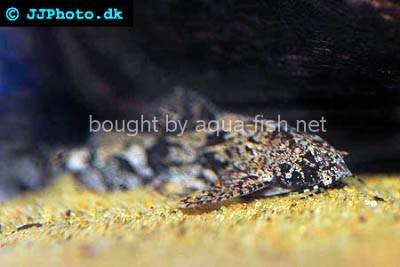Giant moth catfish - Erethistes pusillus
Scientific name: Erethistes pusillus
Common name: Giant moth catfish
Family: Erethistidae
Usual size in fish tanks: 6 - 8 cm (2.36 - 3.15 inch)
014
Recommended pH range: 6.2 - 7
Recommended water hardness: 4 - 13°N (71.43 - 232.14ppm)
0°C 32°F30°C 86°F
Recommended temperature range: 21 - 24 °C (69.8 - 75.2°F)
The way how these fish reproduce: Spawning
Where the species comes from: South Asia
Temperament to its own species: peaceful
Temperament toward other fish species: peaceful
Usual place in the tank: Bottom levels
Introduction
Erethistes pusillus, commonly known as the Giant Moth Catfish, is a peaceful bottom-dwelling species native to the waterways of India and Burma (Myanmar). Known for their unique appearance and calm nature, they are a fascinating addition to aquariums for experienced aquarists who can meet their specific care needs.
Food and Feeding
Giant Moth Catfish can be picky eaters initially, especially when newly introduced to a tank. Over time, they may accept high-quality flake or sinking pellets, but live and frozen foods remain their preferred diet. Offer bloodworms, white worms, daphnia, and brine shrimp to encourage feeding and maintain optimal health. Feed them during the evening hours, as they are more active at night.
Habitat and Tank Requirements
To provide a suitable environment for Giant Moth Catfish, set up a tank with a soft, sandy substrate to protect their delicate barbels. Include hiding spots with driftwood, rocks, and caves, as they enjoy shaded and secure areas. Ensure the tank is equipped with well-oxygenated water and a moderate flow to mimic their natural habitat. Maintain water parameters with a pH range of 6.2-7, hardness of 4-13°N (71.43-232.14 ppm), and a temperature between 21-24°C (69.8-75.2°F). Subdued lighting will help them feel at ease, and regular water changes are essential to maintain high water quality.
Sexing
There are no visible differences between male and female Giant Moth Catfish, making sexing difficult. Behavioral cues during breeding attempts may offer some indications.
Breeding
Breeding Erethistes pusillus in aquariums has not been reported. In the wild, it is believed they are egg scatterers, depositing eggs among plants or in hidden crevices. Replicating these conditions in a controlled setup might encourage spawning behavior, but more research is needed to confirm successful breeding practices in captivity.
Lifespan
With proper care, the expected lifespan of Giant Moth Catfish is over 5 years, making them a rewarding species for dedicated aquarists.
Behavior and Compatibility
Giant Moth Catfish are peaceful and shy, making them best suited for species-specific tanks or community tanks with other calm, non-aggressive species. Suitable tank mates include small tetras, rasboras, or other gentle bottom dwellers such as Corydoras. Avoid keeping them with boisterous or fast-feeding species, as they cannot compete effectively for food. Their nocturnal nature means they are most active during the evening and night.
Short Description
Erethistes pusillus, or Giant Moth Catfish, is a peaceful bottom-dweller that requires well-oxygenated, clean water and a calm tank environment. Subdued lighting and hiding places are essential for their comfort, and their unique behavior makes them a fascinating addition for aquarists willing to meet their specific needs.
Pictures
Bought by aqua-fish.net from jjphoto.dk.





